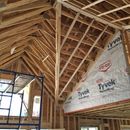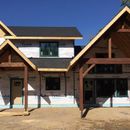Vaulted / Cathedral Ceiling — Unvented
Hi, I’m in the process of building a cabin near Saskatoon, Saskatchewan, Canada. I can’t tell for sure since the climate zone map is for the US only, but I’m guessing this would be equivalent to Zone 6B or 7B.
Part of the cabin has a vaulted or cathedral style ceiling. I’ve read the ‘How to Build an Insulated Cathedral Ceiling’ article and am concerned the recommendations of all the contractors I’ve talked to up there suggest to vent this ceiling structure. No-one has heard of doing an unvented ceiling. The response I get is the roof will get too hot if you don’t vent it or you’ll trap moisture in the ceiling without air movement to dry it out. After reading the article mentioned above I realize this is inaccurate.
The cathedral ceiling area was built with engineered rafters/trusses which are ~18 inches deep. I’ve attached a few pictures. The part of the cabin that has the cathedral ceiling is in the right side of the cabin when looking at the ‘cabin exterior’ picture. The roof-line is perpendicular to the roof-line of the 2nd story section.
Part of my concern is one side of the cathedral ceiling butts into a second story of the cabin, which means there is no soffit system at the lower edge of the roofline to provide an entrance for air to travel up vent channels that would then exit at a ridge vent. The other side of the cathedral ceiling has a soffit that runs the full length of the roofline so this side could draw air into the soffits, up the vent channels, and out the ridge vent.
My general contractor suggests doing standard insulation similar to a wall. Vapor barrier (poly-ethylene), batts of fiberglass insulation, vented air channel, building sheathing, asphalt shingles. A spray foam contractor suggests installing some Rockwool (Roxul) batt insulation 5″ away from the building sheathing then spray foaming against this on the interior side. Essentially using the Rockwool insulation as a backer fill because its cheaper than the spray foam and is denser than fiberglass insulation so it won’t likely move/sag over time. The spray foam would provide a vapor barrier. The ceiling would then be finished below the spray foam. It’s likely there would be some amount of air gap between the spray foam and the finished ceiling since the rafters/trusses are 18″ deep and I doubt it would all be filled in. The 5″ gap mentioned earlier between the Rockwool batt and the roof sheathing would create the vented channel.
After reading the GBA article mentioned above I think the safer option is to build an unvented ceiling and I’d like to confirm how the option for spray foaming on the underside of the roof sheathing (“flash and batt” I believe) would work since asphalt shingles have already been installed so I can’t install rigid foam insulation above the roof sheathing.
If I assume my climate zone is 7B does that mean the spray foam applied to the underside of the roof sheathing must be R-30 by itself?
Then I’d need to install any type of batt insulation that would provide a minimum R-value of R-19 ex. fiberglass, rockwool (roxul), cellulose?
In total this would provide the minimum R-value of R-49 mentioned in the article above. What would you recommend for a total R-Value in zone 7B?
After the insulation I understand no additional vapor barrier (ex. poly-ethylene) is installed because we want the batt insulation to dry to the interior if necessary. Given the rafters/trusses provide 18″ of depth to the roof sheathing and I’m not likely to fill that in order to achieve R-49 to R-60 can I just leave an air space between the batt insulation and the finished ceiling?
Now here’s a part I’m not quite sure about. If I’m planning to install a T&G fir (or pine) ceiling do I need to install a substrate on the interior side of the batt insulation ex. dry-wall that’s taped/mud/primed?
If I do need a substrate of some kind what’s the most economical option above T&G fir?
In other related articles I saw it was mentioned the substrate acted as an additional air barrier, but in this case is it needed since R-30 spray foam was applied?
I appreciate your help,
Arden
GBA Detail Library
A collection of one thousand construction details organized by climate and house part











Replies
Arden,
I can't resist including a link to a relevant article -- even though it's too late for you to take the advice in the article. Here is the link: Plan Ahead for Insulation.
OK, now that I've gotten that out of the way, let's answer your questions.
First of all, here is a link to a page that provides climate zone information for Canada: Climate Zone Map Including Canada. I'd say that Saskatoon is in Zone 7.
You are certainly correct that if a roof valley prevents having each rafter bay connected to a soffit vent, then all vented solutions are impossible. You need to create an unvented insulated roof assembly.
Flash-and-batt makes sense. For more information, see Flash-and-Batt Insulation.
In Zone 7, you'll need R-30 of closed-cell spray foam installed against the roof sheathing, plus R-19 of some type of fluffy insulation in direct contact with the cured spray foam. You don't want any interior polyethylene, but if your code inspector insists on some type of interior membrane -- a common problem in Canada -- you can install a so-called "smart" vapor retarder like MemBrain to keep the inspector happy.
Arden,
Q. "R-49 is the minimum insulation we discussed above, but what would you recommend for a total R-Value in this ceiling for zone 7?"
A. From a building science perspective, anything in the range of R-49 to R-60 would work. Remember that you probably have to comply with local codes -- check to see what regulations apply in Saskatchewan.
Finally, remember that the ratio of spray foam insulation to fluffy insulation matters. In your climate zone, the R-value of the spray foam layer must represent at least 61% of the R-value of the the entire roof assembly. That means that if you install more than R-49, you'll need more spray foam as well as more fluffy insulation. For more details on this principle, see Combining Exterior Rigid Foam With Fluffy Insulation. (Although the article refers to rigid foam on the exterior side of the roof sheathing, the ratio rules discussed in the articles also apply to flash-and-batt installations.)
Q. "Given the rafters/trusses provide 18 inch of depth to the roof sheathing and I'm not likely to fill all that with R-49 to R-60 combined closed cell spray foam and batt insulation, can I just leave air space between the batt insulation and the finished ceiling?"
A. Yes, as long as you have a mechanism to keep the fluffy insulation in direct contact with the cured spray foam.
Q. "If I'm planning to install a T&G fir (or pine) ceiling do I need to install a substrate on the interior side of the batt insulation (ex. dry-wall that's taped/mud/primed) vs. attaching the T&G boards to the rafters with strapping? In other related articles I saw (possibly for a vented ceiling system) it was mentioned the substrate acted as an additional air barrier, but in my case is it needed since R-30 spray foam will be applied?"
A. Check with your local code inspector, if there is one, concerning the need for a thermal barrier (for fire safety) on the interior side of the spray foam. In most jurisdictions, fiberglass batts or mineral wool batts are adequate, but some inspectors may require 1/2-inch drywall as a thermal barrier. It never hurts to have an additional air barrier on the interior in any case, and 1/2-inch drywall is an air barrier.
Q. "If I do need a substrate of some kind do you have a recommendation for the most economical option above T&G fir?"
A. Half-inch drywall, with the seams taped with drywall compound. One layer of mud on the seams is plenty -- there is no need to sand the joints or make them look pretty.
Martin,
Thanks so much for your responses. Have a good long weekend.
Arden
Martin,
Thank you for your reply. Funny you mentioned it, but I actually did read the 'Plan Ahead for Insulation' article prior to building. Unfortunately, contractors in the area weren't familiar with installing rigid foam insulation on the roof. The cabin is located in a remote-ish area and getting contractors out from the nearest cities that might be familiar with these installation practices is near impossible and/or extremely costly. Discussions with spray foam contractors willing to make the trip to the cabin made me a little more comfortable that they would be able to complete the 'Flash and Batt' insulation technique.
I was hoping you might be able to provide some advice on the following questions. I've seen answers in different articles, but not for my exact situation.
1. R-49 is the minimum insulation we discussed above, but what would you recommend for a total R-Value in this ceiling for zone 7?
2. Given the rafters/trusses provide 18" of depth to the roof sheathing and I'm not likely to fill all that with R-49 to R-60 combined closed cell spray foam and batt insulation can I just leave air space between the batt insulation and the finished ceiling?
3. a. If I'm planning to install a T&G fir (or pine) ceiling do I need to install a substrate on the interior side of the batt insulation ex. dry-wall that's taped/mud/primed vs. attaching the T&G boards to the rafters with strapping? In other related articles I saw (possibly for a vented ceiling system) it was mentioned the substrate acted as an additional air barrier, but in my case is it needed since R-30 spray foam will be applied?
b. If I do need a substrate of some kind do you have a recommendation for the most economical option above T&G fir?
Thanks again for you help.
Arden